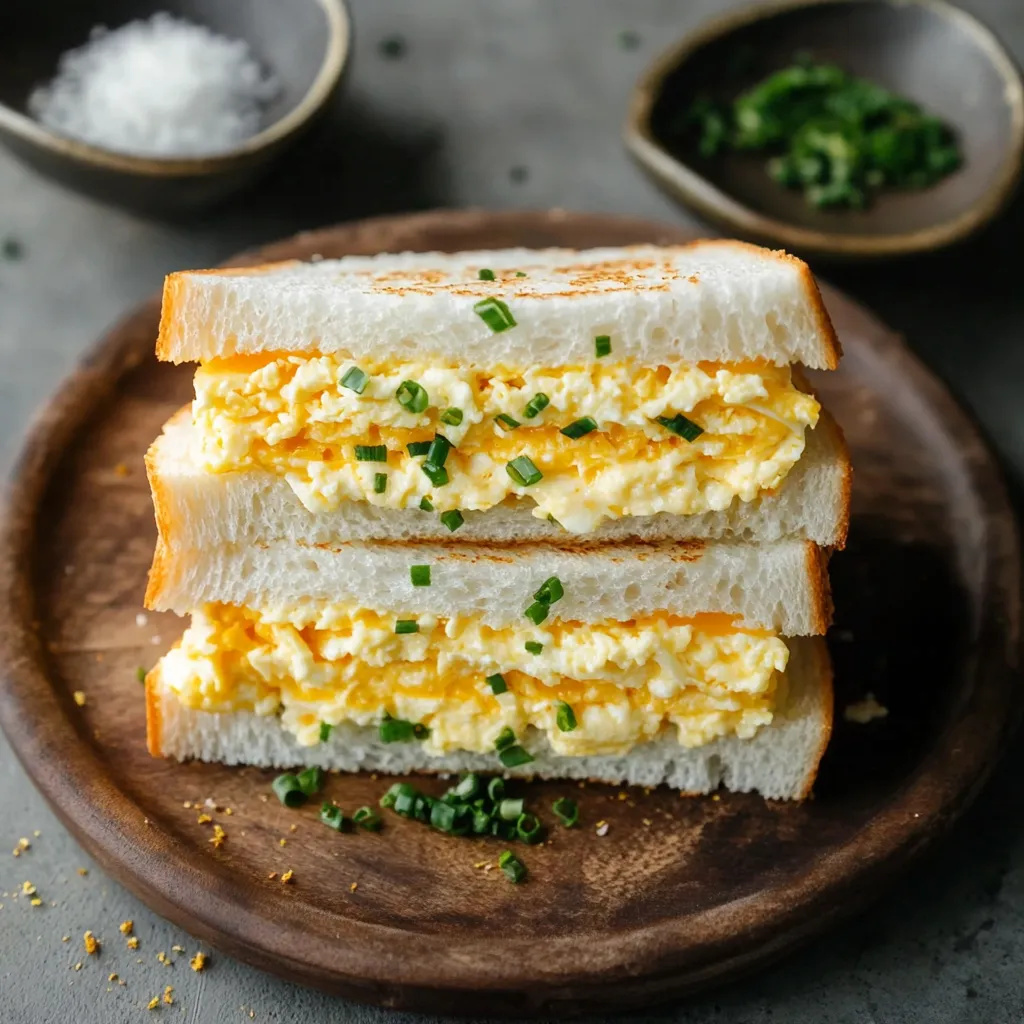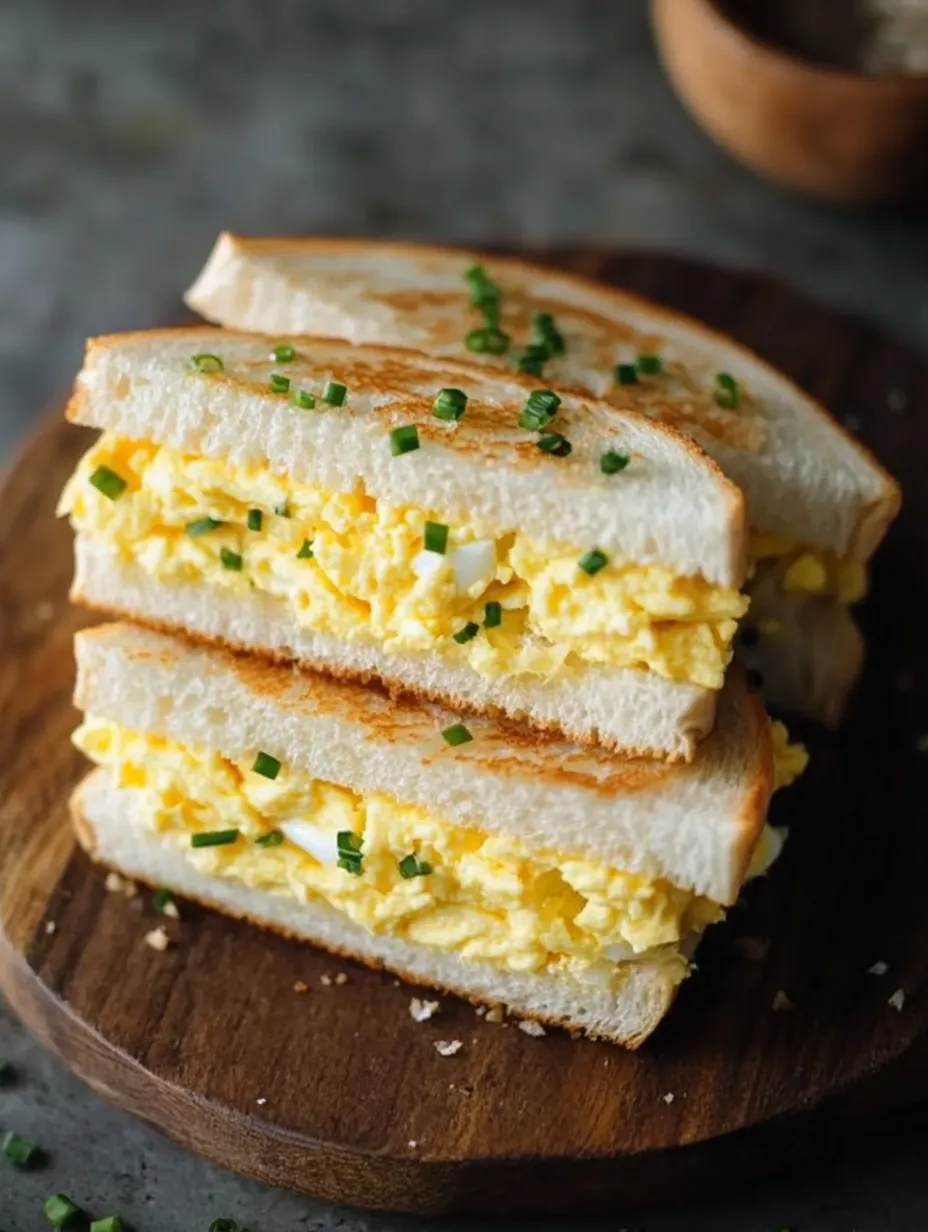 Pin it
Pin it
Velvety soft-boiled eggs blended with rich Japanese mayonnaise create a luxurious filling that's nestled between pillowy slices of milk bread in this iconic Japanese convenience store classic. This Tamago Sando transforms humble ingredients into something truly special through careful preparation and attention to detail. The perfect balance of creamy egg salad against the tender, slightly sweet bread creates a harmonious bite that's simultaneously simple and sophisticated – comfort food elevated to an art form.
I first encountered tamago sando during a trip to Tokyo, where I became obsessed with the convenience store versions sold in every 7-Eleven and Lawson. After returning home, I spent weeks perfecting my recipe to capture that distinctive texture and flavor. Now it's become my go-to impressive-yet-easy lunch when friends visit, always earning surprised delight at how something so simple can taste so special.
Essential Elements
- High-quality eggs: The star ingredient deserves the best quality. Farm-fresh eggs with bright orange yolks create the most flavorful and colorful filling.
- Japanese mayonnaise: Creates that distinctive rich, tangy flavor. Kewpie brand with its signature squeeze bottle is traditional and worth seeking out.
- Milk bread (shokupan): Provides the perfect pillowy vessel. Its light, slightly sweet texture is traditional, though good-quality white sandwich bread can substitute.
- Sugar: Balances the savory elements with subtle sweetness. Just a small amount enhances the egg's natural flavor.
- Salt and pepper: Simple seasonings that let the eggs shine. Freshly ground black pepper makes a noticeable difference in flavor.
- Unsalted butter: Creates a moisture barrier that prevents soggy bread. European-style butter with higher fat content spreads most easily.
- Optional milk: Lightens the texture when using fully hard-boiled eggs. Just a splash creates a fluffier consistency.
 Pin it
Pin it
Sandwich Artistry
- Egg Perfection:
- Begin by preparing the eggs, the heart of this sandwich. Place your eggs in a saucepan and cover with cold water by about an inch. Bring the water to a rolling boil over high heat, then immediately reduce to a simmer and set a timer for exactly 7 minutes for medium soft-boiled eggs. This precise timing creates that ideal custardy texture – not too runny but still creamy. While the eggs cook, prepare an ice bath in a bowl with cold water and ice cubes. When the timer rings, immediately transfer the eggs to the ice bath using a slotted spoon, which halts the cooking process and prevents that grayish ring around the yolk. Allow them to cool for just 2 minutes – long enough to stop cooking but still warm enough to peel easily. Gently tap each egg on a hard surface and roll it to create cracks all over, then peel under a slight trickle of cool water to help separate the shell from the egg.
- Filling Creation:
- Place your peeled eggs in a medium bowl and mash them with a fork until they're broken down into small pieces – larger than minced but smaller than a pea. This coarse texture is crucial for the authentic experience, as it allows for both creamy binding and distinct pieces of egg in each bite. Add the sugar, salt, and freshly ground black pepper to the eggs, then incorporate the Japanese mayonnaise. If you're using fully hard-boiled eggs, add a teaspoon or two of milk to achieve that signature creamy texture. Mix everything together gently but thoroughly, being careful not to overwork the mixture, which would make it too pasty. Taste the filling and adjust the seasonings if needed – the flavor should be rich, slightly sweet, and well-seasoned but not overpowering.
- Beautiful Assembly:
- Take your slices of milk bread and spread each one with a thin, even layer of softened butter, making sure to cover right to the edges. This creates a moisture barrier that prevents the bread from becoming soggy from the egg filling. Spoon the egg salad onto two slices of bread, dividing it equally and spreading it in an even layer, leaving a small margin around the edges to prevent spillage. Top with the remaining slices of bread, butter-side down, and press gently to secure everything together. Using a sharp knife, carefully trim the crusts from the sandwiches for that authentic Japanese convenience store appearance. Finally, slice each sandwich diagonally or straight across the middle, depending on your preference for presentation.
- Thoughtful Presentation:
- For the most authentic experience, wrap each sandwich half tightly in parchment paper or plastic wrap, folding the edges neatly like a present. This not only references the immaculate packaging of Japanese convenience stores but also helps hold the sandwich together for easier eating. If serving immediately at home, place the sandwich halves on a plate with the cut sides facing up to showcase the beautiful egg filling. For an elevated touch, garnish with finely sliced chives or microgreens arranged along the cut edge of the sandwich, adding a pop of color and fresh flavor that complements the rich egg salad.
I learned the importance of the precise egg timing after several attempts that resulted in either too-runny or too-dry fillings. Seven minutes creates that magical consistency where the yolks are just set enough to hold together in the salad while still contributing a luxurious creaminess to the overall texture. This small detail elevates the sandwich from good to exceptional.
Delightful Pairings
Complete your Japanese café experience by serving this sandwich alongside a cup of hot green tea, whose slight bitterness provides the perfect counterpoint to the rich, creamy sandwich. For a more substantial meal, pair with a simple miso soup with tofu and green onions for a traditional Japanese breakfast combination. When entertaining guests for lunch, create an elegant spread by cutting the sandwiches into quarters and serving alongside cucumber salad dressed with rice vinegar and sesame seeds. For a contemporary twist, serve with kettle chips and pickles for a Japanese-American fusion lunch that satisfies all cravings.
Creative Variations
Transform this versatile recipe by adding finely chopped green onions or chives directly into the egg mixture for a subtle onion flavor and specks of green throughout the filling. For a spicier version, incorporate a small amount of wasabi paste or a dash of togarashi (Japanese spice blend) into the mayonnaise before mixing with the eggs. Avocado slices make a luxurious addition, adding creamy richness and beautiful color contrast to each bite. For a heartier sandwich, add a layer of thinly sliced cucumber or crisp lettuce between the egg filling and bread, creating textural contrast while maintaining the essential Japanese character of the dish.
 Pin it
Pin it
Storage Success
While tamago sando is best enjoyed fresh, you can prepare components ahead of time for convenience. The egg salad can be made up to 24 hours in advance and stored in an airtight container in the refrigerator. Bring it to cool room temperature before assembling sandwiches for the best flavor and texture. Fully assembled sandwiches can be wrapped tightly in plastic wrap and refrigerated for up to 48 hours, though the bread may lose some of its softness over time. For the freshest experience when meal prepping, store the egg salad separately and assemble sandwiches just before eating. If you must pre-assemble, the butter barrier becomes even more important for maintaining bread texture during storage.
After countless iterations of this recipe, I've found that what makes a truly exceptional tamago sando isn't fancy additions or complicated techniques, but rather attention to detail with the basics – perfectly cooked eggs, quality mayonnaise, and fresh bread. This sandwich reminds us that when each component is treated with care, even the simplest foods can become extraordinary experiences. Whether enjoyed as a quick breakfast, elegant lunch, or midnight snack, this Japanese egg sandwich offers a moment of pure comfort and satisfaction with every bite.
Frequently Asked Questions
- → What is Japanese mayonnaise and where can I find it?
- Japanese mayonnaise (often sold under the brand name Kewpie) is richer and tangier than American mayo. It's made with egg yolks instead of whole eggs and uses rice or apple vinegar. You can find it in Asian grocery stores, international sections of supermarkets, or online. If you can't find it, regular mayonnaise will work, but try adding a tiny splash of rice vinegar and a pinch of sugar to get closer to that distinctive flavor.
- → Can I use regular white bread instead of Japanese milk bread?
- While Japanese milk bread (shokupan) gives the authentic texture with its soft, fluffy consistency, you can use regular white bread in a pinch. Look for a high-quality, thick-cut white bread for the best results. Brioche can also work as a substitute since it has a similar slight sweetness.
- → Why do you add sugar to the egg salad?
- The small amount of sugar isn't enough to make the egg salad sweet - it just balances the flavors and is characteristic of Japanese cooking, which often includes a touch of sweetness even in savory dishes. It helps bring out the natural flavors of the eggs and complements the tanginess of the mayonnaise.
- → How important is removing the crusts from the bread?
- Removing the crusts is traditional for Japanese sandwiches and gives them their characteristic neat appearance. It also ensures a consistent soft texture throughout. That said, it's purely aesthetic - the sandwich will taste the same with or without crusts, so you can skip this step if you prefer.
- → Can I prepare the egg salad in advance?
- Yes! The egg salad can be prepared up to 2 days ahead and stored in an airtight container in the refrigerator. This actually allows the flavors to meld together nicely. Just wait to assemble the sandwiches until shortly before serving for the best texture, or if packing for lunch, assemble in the morning and make sure to butter the bread well to prevent sogginess.
